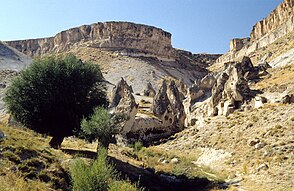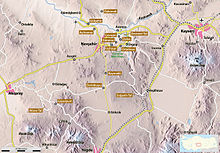Soğanlı Valley
| Soğanlı Valley | ||
|---|---|---|
|
Caves and pigeon houses in the Soğanlı Valley |
||
| location | Circle Yeşilhisar in the province of Kayseri ( Turkey ) | |
| Mountains | Cappadocia | |
| Geographical location | 38 ° 20 '41 " N , 34 ° 58' 14" E | |
|
|
||
The Soğanlı Valley is located in the Yeşilhisar district of the Turkish province of Kayseri , in the southeast of the Cappadocia region . In the valley, numerous rock-hewn churches and cave structures have been worked into the soft tuff of the Cappadocian landscape.
Aşağı Soğanlı (Lower Soğanlı ) is located in the southeastern part of the valley , and in the further course the valley forks into a northern and a southern part. At the fork is Yukarı Soğanlı (Upper Soğanlı ). The valley was inhabited by Byzantine monks from the 9th to the 13th centuries. About 100 churches in the valley and the associated caves and monastery rooms come from them , most of which, however, have been buried or collapsed or are used as stables. Noteworthy are the many pigeon houses carved into the rock , the entry holes of which are marked with white paint.
Churches
Before the valley branches off at Aşağı Soğanlı, there is the Tokalı Kilise (Buckle Church), not to be confused with the church of the same name in Göreme . It is located high in a rock wall and is accessible via a steep staircase with over 50 steps. Tombs are carved into the wall in front of the church . Inside there is a three-aisled church, the frescoes of which have been almost completely destroyed.
The Karabaş Kilisesi (Church with the Black Heads) in the northern valley has a nave with a barrel vault . According to an inscription by the Byzantine general Michael Skepides above the west door, the youngest layer of frescoes dates from the 13th century. The depictions show scenes from the life of Jesus, although not the heads are black, but the background. Several outbuildings suggest that it is a monastery complex.
Also in the northern valley is the barrel-vaulted Yılanlı Kilise (Snake Church ). In a side building there are two arcosol tombs carved into the rock . Their frescoes were painted black and are badly damaged. Opposite it is the Kubbeli Kilise (domed church) with adjoining rooms from the 10th century, which is worked into a single rock cone. The cone is decorated on the outside with imitation cuboids and a toothed cornice , which is supposed to give the impression of a free-standing church.
In the southern valley there is also the barrel-vaulted Barbara Church, also Tahtalı Kilise (wooden church) with a hall and a side chapel around a courtyard. After a difficult to read inscription, it can be dated to 1006 or 1021. In addition to frescoes with New Testament content, a representation of the dormice of Ephesus, unique in Cappadocia, is remarkable. It got its Turkish name from a wooden footbridge over which it can be reached.
economy
The inhabitants of the valley live mainly from agriculture. The pigeon manure is collected from the numerous pigeon houses as fertilizer and applied to the fields. Since the area is away from the Cappadocian core region and there is no connection with public transport ( Dolmuş ), it is still little developed for tourism (as of 1995).
See also
literature
- Peter Daners, Volher Ohl: Cappadocia . Dumont, 1996, ISBN 3-7701-3256-4
- Marianne Mehling (Hrsg.): Knaur's cultural guide in color Turkey . Droemer-Knaur, 1987, ISBN 3-426-26293-2
- Michael Bussmann / Gabriele Tröger: Turkey . Michael Müller Verlag 2004 ISBN 3-89953-125-6




